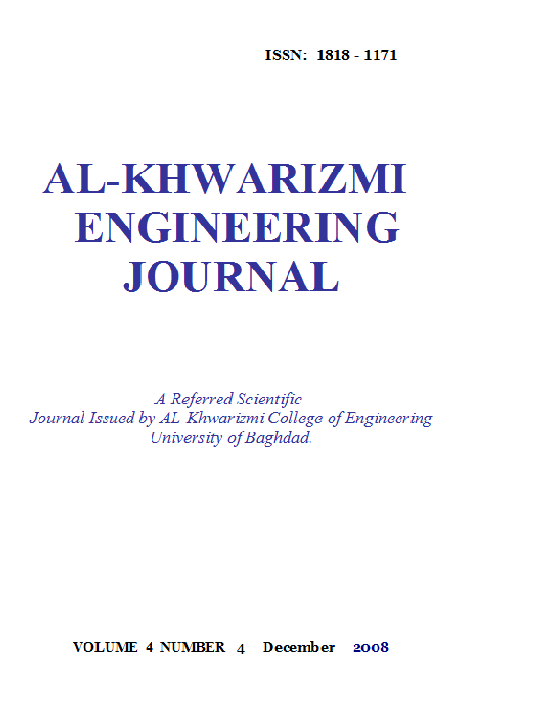Parametric Study of Mixed Convective Radiative Heat Transfer in an Inclined Annulus
Abstract
The steady state laminar mixed convection and radiation through inclined rectangular duct with an interior circular tube is investigated numerically for a thermally and hydrodynamicaly fully developed flow. The two heat transfer mechanisms of convection and radiation are treated independently and simultaneously. The governing equations which used are continuity, momentum and energy equations. These equations are normalized and solved using the Vorticity-Stream function and the Body Fitted Coordinates (B.F.C) methods. The finite difference approach with the Line Successive Over-Relaxation (LSOR) method is used to obtain all the computational results. The (B.F.C) method is used to generate the grid of the problem. A computer program (Fortran 90) is built to calculate the steady state Nusselt number (Nu) for Aspect Ratio AR (0.55-1) and Geometry Ratio GR (0.1-0.9). The fluid Prandtl number is 0.7, Rayleigh number Ra = 400, Reynolds number Re = 100, Optical Thickness (0 ≤ t ≤ 10), Conduction- Radiation parameter (0 ≤ N ≤ 100) and Inclination angle λ = 45. For the range of parameters considered, results show that radiation enhance heat transfer. It is also indicated in the results that heat transfer from the surface of the circle exceeds that of the rectangular duct. Generally, Nu is increased with increasing GR, t and N but it decreased with AR increase. When the radiation effect added to the heat transfer mechanism, the heat transfer rate increased. This effect increased with increasing in GR and decreasing with AR. The increasing in radiation properties lead to increase the radiation effect. Tecplot 7 program was used to plot the curves which cleared these relations and isotherms and streamlines which illustrate the behavior of air through the channel and its variation with other parameters. A correlation equation is concluded to describe the radiation effect. Comparison of the results with the previous work shows a good agreement.
Downloads
References
[2] Bello-Ochende F. L. (1985), A Numerical Study of Natural Convection in Horizontal Elliptic Cylinders, Revista Brasileira de Ciências Mecânicas, Vol. VII, No.3,pp.185-207.
[3] Bello-Ochende F. L. and Adegun I. K. (1993), A perturbation Analysis of Combined Free and Forced Laminar Convection in Tilted Elliptic Cylinders, The 6th International Symposium on Transport Phenomena in Thermal Engineering, Seoul, Vol. III, pp.121-125.
[4] Bello-Ochende F. L. and Adegun I. K. (2002), Combined Mixed Convective and Radiative Heat Transfer in a Tilted Rotating Uniformly Heated Square Duct With a Centered Circular Cylinder International Journal of Heat and Technology, Vol. 20, No.1, pp.21-30.
[5] Dehghan A. A. and Behnia M. (1996), Combined Natural Convection–Conduction and Radiation Heat Transfer in a Discretely Heated Open Cavity, Journal of Heat Transfer, Vol. 118, pp.56-64.
[6] Dong Z. F., Ebadian M. A. and Bigzadeh E. (1993), Convective-Radiative Heat Transfer in a Square Duct with a Centered Circular Core, International Journal of Heat and Fluid Flow, Vol. 14, No. 1, pp. 68-75.
[7] Fletcher C. A. J. (1988), Computational Fluid Techniques for Fluid Dynamics 2, Springer-Verlag.
[8] Siegel R. (1985), Analysis of Buoyancy Effect on Fully Developed Laminar Heat Transfer in a Rotating Tube, Journal of Heat Transfer, Vol.107, pp. 338-344.
[9] Yang G. and Ebadian M. A. (1991), Thermal Radiation and Laminar Forced Convection in the Entrance of a Pipe With Axial Conduction and Radiation, Int. J. Heat Fluid Flow, Vol.12, No. 3 pp. 202-209.
Downloads
Published
Issue
Section
License
Copyright: Open Access authors retain the copyrights of their papers, and all open access articles are distributed under the terms of the Creative Commons Attribution License, which permits unrestricted use, distribution, and reproduction in any medium, provided that the original work is properly cited. The use of general descriptive names, trade names, trademarks, and so forth in this publication, even if not specifically identified, does not imply that these names are not protected by the relevant laws and regulations. While the advice and information in this journal are believed to be true and accurate on the date of its going to press, neither the authors, the editors, nor the publisher can accept any legal responsibility for any errors or omissions that may be made. The publisher makes no warranty, express or implied, with respect to the material contained herein.












